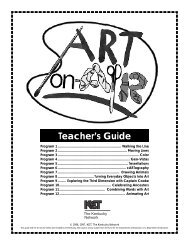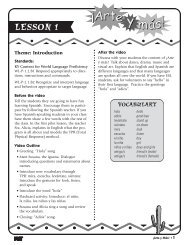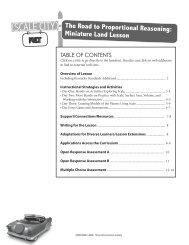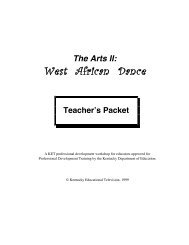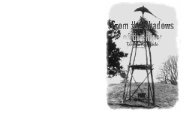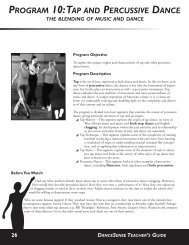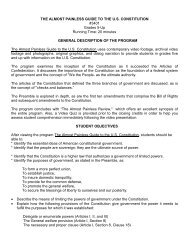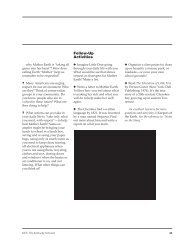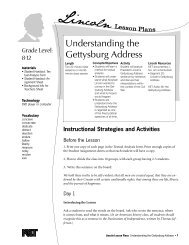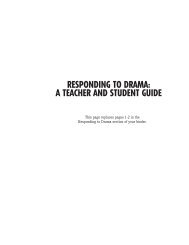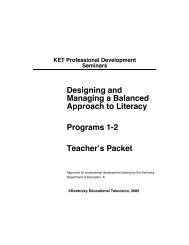7369 old music 2402 - KET
7369 old music 2402 - KET
7369 old music 2402 - KET
You also want an ePaper? Increase the reach of your titles
YUMPU automatically turns print PDFs into web optimized ePapers that Google loves.
this case, the designers were looking<br />
for something inspired by the <strong>music</strong><br />
and the format of the series. One idea<br />
was to create a set that had an <strong>old</strong>-time<br />
tent show feeling to it. That led them to<br />
a book of paintings by American artist<br />
Thomas Hart Benton. Find a book of<br />
his paintings for your students to<br />
explore, analyze, and enjoy.<br />
Other Family Traditions<br />
Ask each student to identify some<br />
aspect of folklore in their home life. It<br />
could be a story from their parents or<br />
family, a jump rope game, a rhyme or<br />
riddle learned from a friend or family<br />
member (other than a verbatim TV<br />
jingle). Organize a “Trading Traditions<br />
Day” when the students share their<br />
stories, games, and riddles by telling<br />
how they learned them and where they<br />
came from and then by teaching them<br />
to and performing them with classmates.<br />
Connections Across the<br />
Curriculum<br />
This series lends itself to research<br />
and writing opportunities; to exploring<br />
and analyzing time periods, patterns of<br />
migration, and other events in our<br />
nation’s history and development; and<br />
to learning about and appreciating<br />
ethnic and cultural contributions and<br />
influences.<br />
Social studies is an area where crosscurricular<br />
connections are natural. For<br />
example, you might enhance a social<br />
studies unit on the Civil War and<br />
slavery by using Program 4, in which<br />
Sparky and Rhonda Rucker sing a code<br />
song from the period, “The Gospel<br />
Train,” and Program 11, with Odetta<br />
talking about the westward movement<br />
of African-Americans following the<br />
war. In fact, many of the performers<br />
include songs about the life, history,<br />
and contributions of African-<br />
Americans as well as about contemporary<br />
issues such as civil rights.<br />
Several of the programs could also<br />
be used in an exploration of sound<br />
(science and <strong>music</strong>). Malcolm Dalglish<br />
(Program 1) and Mike Seeger (Program<br />
14), for example, both discuss how the<br />
length of a string or a pipe affects the<br />
highness or lowness of a <strong>music</strong>al pitch.<br />
Incorporating Community<br />
Resources<br />
Who are the artists and <strong>music</strong>ians in<br />
your community? Can you invite them<br />
into your classroom to share and<br />
perform? Where can you take your<br />
students so they can experience a<br />
<strong>music</strong>al performance firsthand? Here<br />
are some ideas to get you started:<br />
• Invite a community storyteller,<br />
singer, or <strong>music</strong>ian to class for a<br />
discussion. Perhaps a parent<br />
performs or carries on a traditional<br />
art form and would be<br />
willing to come to your class.<br />
• Ask teachers or other workers<br />
within your school for suggestions<br />
about artists/<strong>music</strong>ians in<br />
your community. A nearby<br />
college or arts organization<br />
might be able to lead you to<br />
artists who would be willing to<br />
come into your classroom.<br />
• Does your local college have a<br />
folklore department or someone<br />
in the <strong>music</strong> department who<br />
could visit your class?<br />
• Apply for a grant to bring in a<br />
<strong>music</strong>ian, storyteller, or instrument<br />
maker. Most states have<br />
arts councils that either provide<br />
grants to bring artists into<br />
schools or can help teachers find<br />
ways of bringing artists in.<br />
• Think about all of the cultures<br />
that may be represented in your<br />
community or school (African,<br />
Hispanic, Japanese, Vietnamese,<br />
Middle Eastern, Caribbean, or<br />
others represented by exchange<br />
students who may be in your<br />
school system for the year—the<br />
possibilities are endless). Are<br />
there volunteers from these<br />
groups willing to visit your<br />
class? If so, ask them to bring<br />
recordings of their <strong>music</strong> with<br />
them so students can compare<br />
and contrast the <strong>music</strong> from<br />
different cultures. Convey to<br />
students the importance of<br />
appreciating and showing<br />
respect for all types of culture<br />
that surround them.<br />
• Ask a traditional dance caller to<br />
come to class and teach.<br />
• Visit a local <strong>music</strong> festival, folk<br />
dance, or other community<br />
event.<br />
Sing-Along<br />
Many of the songs in this series have<br />
a purpose—to help a baby get to sleep,<br />
to make working a bit easier. Some<br />
songs are just meant to make us laugh<br />
and have fun. Whatever their other<br />
purposes, we hope the Old Music for<br />
New Ears songs will get you and your<br />
students singing, clapping, moving, and<br />
playing along.<br />
<strong>KET</strong>, The Kentucky Network 11



